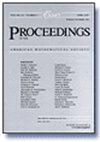A remark on a paper by F. Chiarenza and M. Frasca
IF 0.8
3区 数学
Q2 MATHEMATICS
引用次数: 0
Abstract
In 1990 F. Chiarenza and M. Frasca published a paper in which they generalized a result of C. Fefferman on estimates of the integral of
对 F. Chiarenza 和 M. Frasca 论文的评论
1990 年,F. Chiarenza 和 M. Frasca 发表论文,将 C. Fefferman 关于 p > 1 p>1 时通过 | D u | p |Du|^{p} 的积分来估计 | b u | p |bu|^{p} 的积分的结果加以推广。形式上,他们的证明仅对 d ≥ 3 d\geq 3 有效。我们在这里用一个不同的证明来进一步概括,在这个证明中,对于任何维度 d ≥ 2 d\geq 2,D D 被替换为拉普拉奇的分数幂。
本文章由计算机程序翻译,如有差异,请以英文原文为准。
求助全文
约1分钟内获得全文
求助全文
来源期刊
CiteScore
1.70
自引率
10.00%
发文量
207
审稿时长
2-4 weeks
期刊介绍:
All articles submitted to this journal are peer-reviewed. The AMS has a single blind peer-review process in which the reviewers know who the authors of the manuscript are, but the authors do not have access to the information on who the peer reviewers are.
This journal is devoted to shorter research articles (not to exceed 15 printed pages) in all areas of pure and applied mathematics. To be published in the Proceedings, a paper must be correct, new, and significant. Further, it must be well written and of interest to a substantial number of mathematicians. Piecemeal results, such as an inconclusive step toward an unproved major theorem or a minor variation on a known result, are in general not acceptable for publication. Longer papers may be submitted to the Transactions of the American Mathematical Society. Published pages are the same size as those generated in the style files provided for AMS-LaTeX.

 求助内容:
求助内容: 应助结果提醒方式:
应助结果提醒方式:


